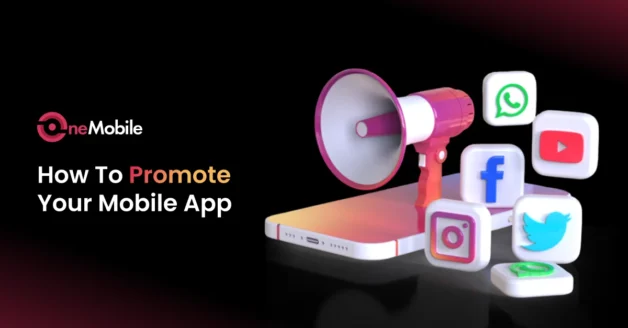October 20, 2025
9 Mobile Commerce Trends & How to Sell Smarter in 2025
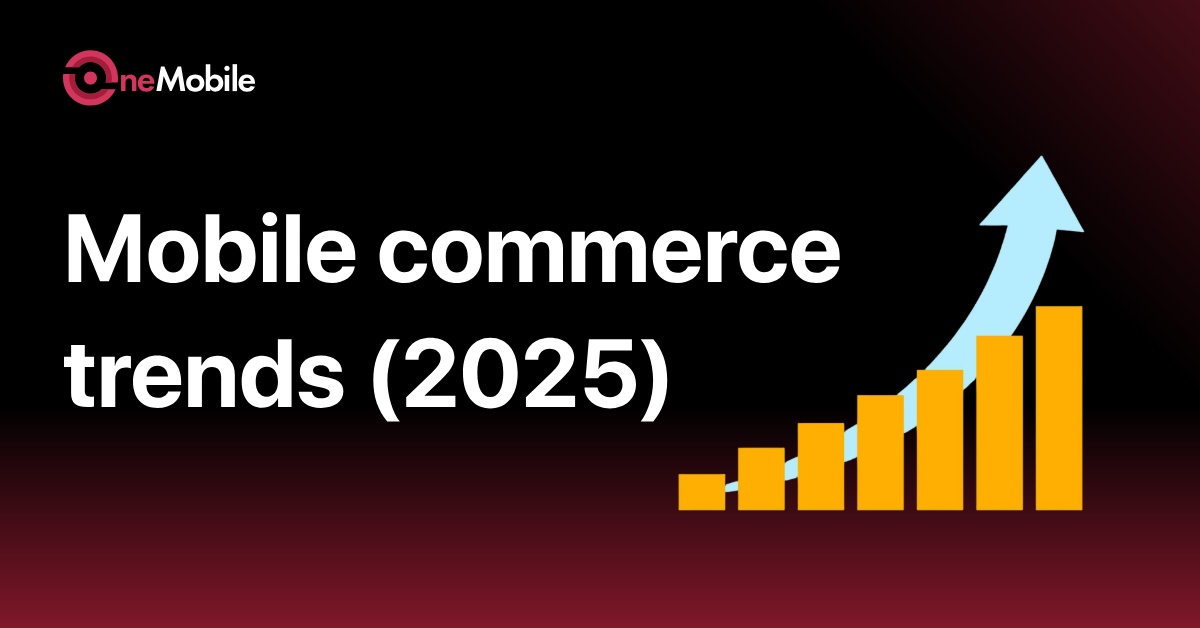
Most of us shop on our phones – does it sound right? And if your business isn’t thinking mobile-first, you’re already behind.
In 2025, mobile commerce (or m-commerce) is exploding. From TikTok shops to one-click checkouts, the way people buy is changing fast.
At OneMobile, we see this shift every day. That’s why this blog goes beyond buzzwords. We’ll break down the key mobile commerce trends, share real examples, and give you practical steps to level up your mobile strategy, whether you’re just getting started or ready to scale.
Let’s jump in!
The current state of mobile commerce (2025 snapshot)
Mobile commerce is dominating.
Right now, over 70% of all e-commerce happens on mobile. People are browsing, comparing, and buying directly from their phones, whether they’re on the bus, in bed, or between meetings.
Why? Because mobile shopping is fast, easy, and always within reach.
But here’s the thing: it’s not just about having a mobile site anymore. Shoppers expect smooth, personalized experiences – apps that load fast, checkouts that take seconds, and even product suggestions that feel spot-on.
And businesses that get this are winning.
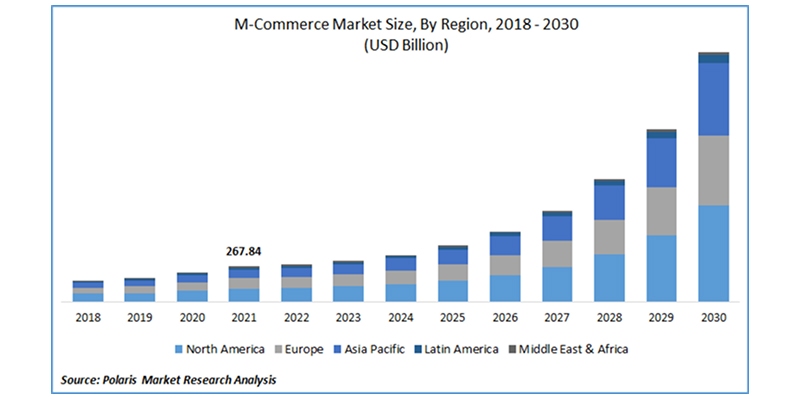
9 mobile commerce trends to watch in 2025 (and why they matter)
The mobile commerce world is moving fast. Let’s break down the top trends that are shaping how people shop and how you can use them to grow your business.
1. Mobile apps over mobile web
Mobile websites are useful, but apps are where the real engagement happens. Customers are spending more time in branded apps because they’re faster, easier to navigate, and offer more personalized experiences.
Why it matters:
- Apps convert better than mobile websites (up to 3x higher).
- You can send push notifications, track behavior, and build loyalty more easily.
Your move: If you don’t have a mobile app yet, now’s the time. Start simple, focus on speed, ease of use, and a great checkout flow.
2. Mobile wallets & one-click payments
No one likes filling out payment forms on their phone. That’s why mobile wallets like Apple Pay, Google Pay, and Shop Pay are game-changers. They make checkout lightning-fast, secure, and convenient.
Why it matters:
- Reduces cart abandonment
- Improves mobile conversion rates, especially on the go
Your move: Enable mobile payment options across your site and app. It’s quick to set up and your customers will love you for it.
3. Social commerce
Platforms like TikTok, Instagram, and Facebook are now full-blown shopping hubs. People don’t just scroll; they discover and buy without ever leaving the app.
Why it matters:
- Reduces friction from discovery to checkout
- Especially powerful with younger audiences (Gen Z, Millennials)
Your move: Start tagging products in your Instagram posts and stories. Test shoppable videos on TikTok. Keep it real, engaging, and mobile-first.
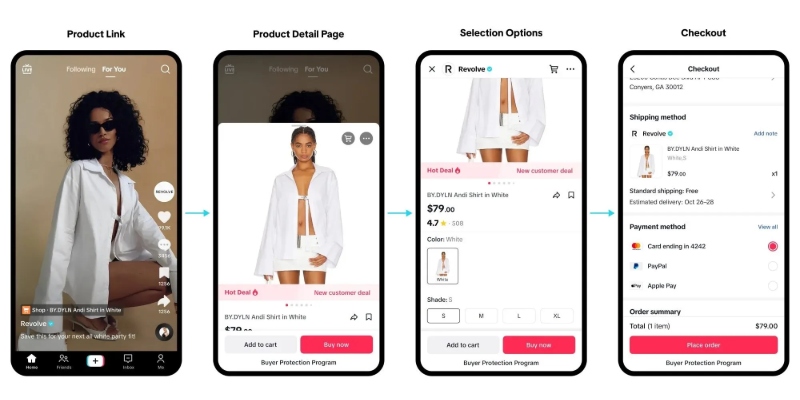
4. One-click ordering
Once made famous by Amazon, this feature is now a standard across many mobile checkout systems, from Shop Pay to Apple Pay. It’s especially effective for repeat orders and impulse buys.
Why it matters:
- Fewer steps = more completed purchases
- Works well for consumables, fashion basics, or trending items
Your move: If your product is something customers re-buy often, offer saved info or a one-click reorder option.

5. Voice commerce
“Hey Siri, order dog food.” This isn’t the future; it’s already happening. Voice assistants like Alexa, Google Assistant, and Siri are making shopping hands-free and even faster.
Why it matters:
- Gaining traction in household purchases and reorders
- Helps brands appear in new shopping contexts (smart homes, cars, etc.)
Your move: Start optimizing your product names and descriptions for voice search. Keep them simple, specific, and easy to pronounce.
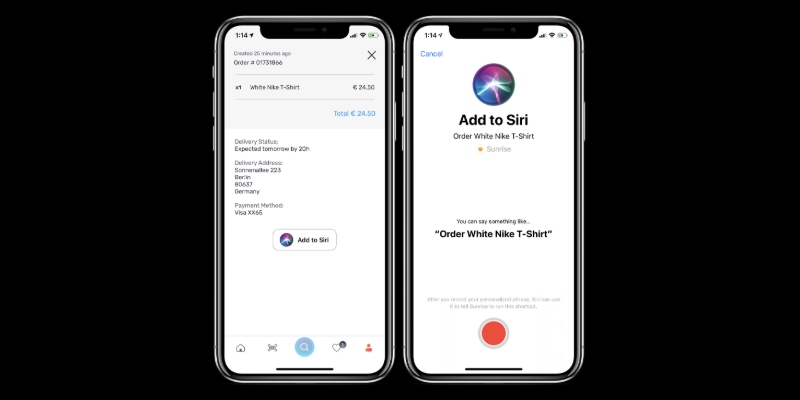
6. Augmented Reality (AR) shopping
From “trying on” sunglasses to placing a couch in your living room virtually, AR helps people make confident buying decisions, especially when they can’t touch the product.
Why it matters:
- Reduces uncertainty and return rates
- Makes shopping more interactive and fun
Your move: Start with just one product. Use a tool like Shopify AR, or partner with a simple 3D preview solution.

7. AI-driven personalization
Your customers don’t want a generic store; they want their version of it. AI helps tailor recommendations, content, and promotions based on behavior and preferences.
Why it matters:
- Increases average order value
- Builds loyalty by making every visit feel custom
Your move: Use customer data (like past purchases and browsing behavior) to create personalized product suggestions or offer smart bundles.
8. Chatbots & conversational commerce
Customers want help now, not an email form. Chatbots can answer common questions, recommend products, and even guide users through the checkout process – all within the app.
Why it matters:
- Saves time for your team
- Increases conversions through guided shopping
Your move: Start with a simple FAQ bot, then evolve into product-focused chat flows. You can even integrate with Messenger or WhatsApp for mobile-first support.

9. Omnichannel experience optimization
Mobile isn’t just one channel; it’s part of a bigger journey. Today’s shoppers might discover your product on Instagram, browse it in your app, and buy it in-store (or vice versa). It all needs to feel connected.
Why it matters:
- Builds trust and consistency across touchpoints
- Increases lifetime value by meeting shoppers where they are
Your move: Make sure your mobile app, website, and any offline experience feel like they’re working together, not in competition.
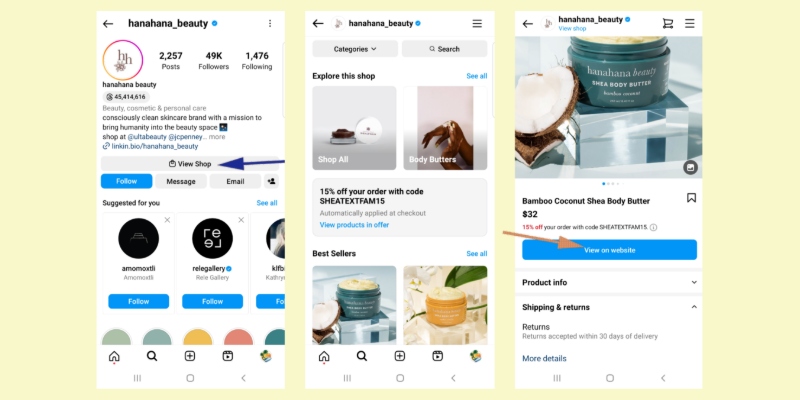
Up next: Want to see how businesses are putting these trends into action? Let’s dive into real examples that work.
Case studies: How real businesses adopt mobile commerce trends
Understanding trends is one thing; seeing them in action is another. Let’s explore how some top brands are turning mobile commerce trends into tangible results:
1. TikTok Shop: Revolutionizing social commerce
TikTok has transformed from a mere entertainment platform to a significant player in the e-commerce space. With features like live shopping and shoppable videos, brands such as P.Louise and Made by Mitchell have achieved million-pound sales through TikTok Live sessions. This approach combines entertainment with instant purchasing, catering to the preferences of Gen Z and millennial consumers. (The Times)
2. Amazon: Mastering one-click ordering
Amazon pioneered the one-click ordering system, streamlining the purchasing process for its users. This feature has significantly reduced cart abandonment rates and enhanced the overall user experience, setting a standard for seamless mobile shopping.
3. Alibaba’s Taobao: Leading in instant commerce
Alibaba’s Taobao platform has introduced an ‘instant commerce’ model, achieving over 40 million daily orders within a month of its launch. By integrating rapid delivery services and a vast merchant network, Taobao meets the growing consumer demand for swift and efficient mobile shopping experiences. (Reuters)
4. Starbucks: Enhancing customer experience with AI
Starbucks utilizes AI to personalize customer experiences through its mobile app. Features like tailored drink recommendations and a rewards system have increased customer engagement and loyalty, showcasing the power of AI-driven personalization in mobile commerce.
5. IKEA: Innovating with Augmented Reality
IKEA’s mobile app incorporates augmented reality (AR) to allow customers to visualize furniture in their own spaces before making a purchase. This feature has enhanced customer confidence and reduced return rates, demonstrating the effectiveness of AR in mobile shopping.
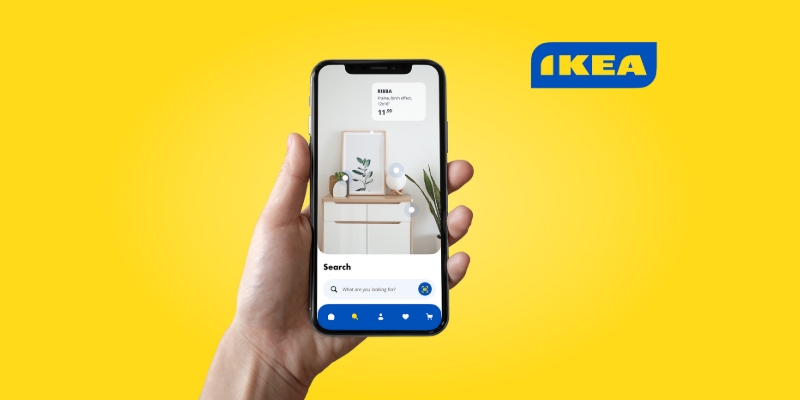
These examples illustrate how integrating mobile commerce trends can lead to significant business growth and customer satisfaction. In the next section, we’ll focus on strategies tailored for small and mid-sized businesses to harness these trends effectively.
Mobile commerce trends by region: What global shoppers expect
Mobile commerce looks different depending on where you are in the world. What works in New York might flop in Tokyo. To really connect with your customers, you need to understand how culture, habits, and technology shape mobile shopping behavior.
Here’s a quick world tour of how mobile commerce is evolving across regions:
1. China: The world’s most advanced mobile shopping market
In China, apps like Taobao, WeChat, and Douyin (TikTok’s sibling) dominate. People shop directly through livestreams, send payments via chat, and expect instant delivery.
| Key takeaway: Seamless, social, and super fast is the norm. If you’re targeting Chinese customers, you’ll need to offer an integrated experience – from chat to checkout. |
2. Nordic countries: All-in on cashless convenience
In Sweden and Norway, cash is nearly extinct. Shoppers expect fast, secure mobile payments, and trust in fintech is high. Mobile wallets like Swish and Vipps are household names.
| Key takeaway: If you’re selling in Europe, prioritize frictionless checkout with localized wallets. |
3. Brazil & LATAM: Social + Mobile is King
In Brazil, Instagram and WhatsApp aren’t just for chatting; they’re core shopping platforms. People often buy directly through DMs or product tags.
| Key takeaway: Visual content and conversational selling work incredibly well. Keep it mobile, fast, and personal. |
4. India: Fast-growing, mobile-first market
With millions of users skipping desktop entirely, India’s mobile commerce boom is driven by budget phones and UPI (Unified Payments Interface) systems like Google Pay and PhonePe.
| Key takeaway: Optimize for lower-bandwidth devices, keep designs clean, and support local payment methods. |
5. Global lesson: Localize everything
From language to currency to how people prefer to browse, local details matter. If you’re expanding internationally, take the time to adjust your mobile experience to fit local norms.
| 💡 Tip: Many features (like multi-language support and currency switching) can be set up easily, so don’t let localization slow you down. |
What’s next in mobile commerce? The shifts you can’t ignore
Mobile commerce is already big; but it’s just getting started. The way people shop is evolving fast, and what feels cutting-edge today could be standard tomorrow.
Here’s a look at what’s coming next and how you can start getting ready:
1. Sustainable & ethical commerce
Shoppers are thinking beyond price tags. They care about where products come from, how they’re made, and how brands treat the planet.
Expect more mobile experiences to highlight eco-friendly packaging, carbon offset options, and transparent sourcing.
⇒ Your move: Start small, share your brand values and give customers the choice to shop sustainably.
2. 5G & instant UX
With 5G becoming more common, mobile apps will load faster, videos will stream smoother, and experiences like AR or 3D product previews will feel almost instant.
⇒ What to do: Make sure your mobile experience is built to scale: lightweight, responsive, and ready for richer content.
3. Hyper-personalization powered by smarter AI
AI won’t just recommend a “You Might Like This” product; it’ll predict when a customer needs a refill, remind them about restocks, or personalize entire app flows based on behavior.
⇒ Start now: Collect useful data (ethically), and use it to make shopping feel easier and more personal.
4. Spatial commerce & wearables
As AR glasses and wearable tech improve, shopping could move into totally new spaces, literally. Imagine browsing a store layout projected into your living room.
Too early to jump in? Maybe. But keeping an eye on this space helps you stay future-ready.
5. Mobile agents & automation
A smart assistant in your app can help customers find products, answer questions, and even complete orders automatically.
⇒ Easy win: A simple chatbot today lays the groundwork for smarter automation tomorrow.
Next up, let’s bring it all together with simple, actionable takeaways to help you move forward.
5 steps you can take right now to stay ahead of mobile commerce trends
You’ve seen the trends, the tools, and what other brands are doing. But where do you start?
Here are 5 simple, doable steps to future-proof your business and make the most of mobile commerce.
Step 1: Audit your mobile experience
Pull out your phone and browse your own site or app. Is it fast? Easy to navigate? Mobile-friendly from start to finish?
Quick fix: Check your loading speed and test your checkout on multiple devices.
Step 2: Enable one-click payments
Add mobile wallets like Apple Pay, Google Pay, and Shop Pay to reduce cart abandonment.
It’s a small step that often leads to a big jump in conversions.
Step 3: Start personalizing – even just a bit
Use your customer data to recommend products, send smarter emails, or show targeted banners.
Not ready for full AI? Even manual segmentation helps.
Step 4: Pick one trend to test
Don’t try to do everything at once. Choose one idea, like social commerce, chatbots, or AR, and run a small test for 30 days.
Track what works, and build from there.
Step 5: Choose tools that grow with you
You don’t need a huge dev team to stay competitive. Platforms like OneMobile are built to help businesses of all sizes launch, optimize, and scale mobile experiences, fast.
No matter where you’re starting, the best time to lean into mobile commerce is now. Your customers are already shopping this way, so make sure your brand is ready to meet them there.
The bottom line
Mobile commerce trends are how people shop, discover, and connect with brands – right now and in the future.
Whether it’s one-click checkouts, social shopping, or smart product suggestions, your customers expect things to be fast, personal, and mobile-friendly. And the good news? You don’t have to be a big brand to deliver that.
Start small. Pick one idea. Build from there. And when you’re ready to scale, OneMobile is here to help, with the tools and support you need to turn mobile commerce trends into real business growth.
Table of Contents
Table of Contents
Read more articles
How To Advertise Your Mobile App During Pre-Launch, Launch and Post-Launch Stage
By Alexandre Le
October 21, 2025
14 Common Apple App Store Rejections and How To Avoid Them
By Alexandre Le
October 21, 2025
